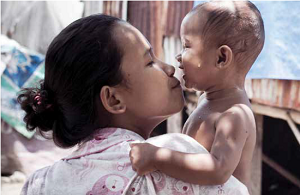We are assisting the urban poor in Cambodia
Published: Mar 4, 2015 Reading time: 3 minutes Share: Share an articleWhile both People in Need and UNICEF have established a longstanding relationship with Cambodia and its people, new challenges due to rapid urbanisation have altered the needs of the people there. An increase in urban poor settlements has placed a strain on typical public aid quantities, and humanitarian assistance must take into account the specific needs of the urban poor in conjunction with available funding.

After assessing many urban poor households, PIN found that the area of Phnom Penh was home to a rising number of underweight children, a lack of pregnancy and childhood nutrition, unsatisfactory vaccination rates, and very high levels of childhood illness. These issues are linked to a lack of education concerning vaccination and proper sanitation methods. The findings were based off of a study of children´s age, weight, height, groups of pregnant and lactating mothers, childhood feeding practices, and dietary patterns that were collected under internationally recognized standards, such as the SMART (Standardized Monitoring and Assessment of Relief and Transitions) approach and the WHO 2006 growth standards in the areas of Dangkor, Mean Chey, Porsen Chey. Russey Keo, and Sen Sok Khans.
To understand the idea of the “urban poor population,” one must first understand the land dynamic in Cambodia, which is increasingly complex as changing regimes turned private land into public land, and later forced residents to relocate to large areas with little employment. To this day, the Cambodian government still struggles to register and recognize land ownership rights. While these settlements are becoming increasingly common, their existence proves detrimental to the residents, who are forced into unemployment, lack of access to adequate markets, lack of water and sanitation, high education dropout rates, and the prevalence of malnutrition.
The poverty that exists in these populations is around 30 percent below the poverty line, and the average poorest family has 6.4 members, most of whom are dependents who receive the lowest nutritional intake. From the survey findings, UNICEF and People in Need recommend that childbearing women should be targeted for malnutrition through rigorous support that includes nutrition counseling, weight monitoring, and vitamin supplementation- specifically calcium. In order to reinforce the need for these initiatives, we suggest that behavior change campaigns are implemented that feature respected individuals and social media in order to appeal to a wide demographic, including the young.
Health and sanitation remains an important focus, as well, and we recommend that community health workers receive further training and information on nutrition and post-natal care. Additionally, urban poor settlements could benefit immensely from coordination and public outreach in dealing with the widespread sanitation issues. In order to improve the health of young, school aged children, education and vaccinations could be more widely provided. The local economy would also benefit from vocational trainings and community advocacy that would in turn empower communities in their search for resources and a clean environment. This could benefit the expansion of local markets and improve working conditions and workers´ rights. While debts remain a problem for many of those who reside in urban poor populations, an increase in financial education programs may help families learn to more efficiently manage their income and debt payments.
These findings indicate that a more focused approach is necessary when considering how best to meet the evolving needs of Cambodia and its people.
